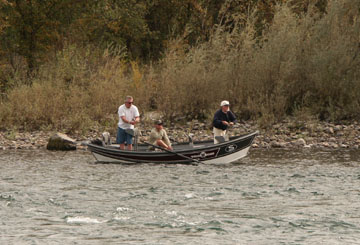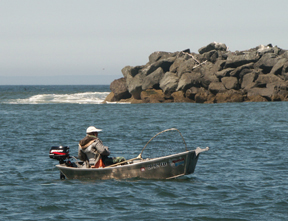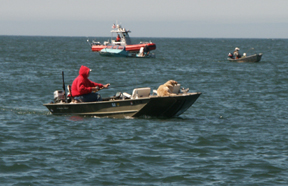Brookings, Oregon and Gold Beach (Rogue River)
July 26, 2007 "I am not Worthy!"

Creeks, streams, rivers and lakes beckon me, but of late the Pacific Ocean whispers promises of bigger water and bigger fish. My growing fascination for ocean fishing caught me by surprise. Bloody bait and endless trolling never appealed to me, but in truth, it is fishing that requires more patience than what I could have endured in my younger years. Had the label "Attention Deficit Disorder" been around during my school days, I certainly would have qualified. It is not that I elevate trout fishing or bass fishing above bottom fishing or salmon fishing, it is simply that the former both offer continuous casting and mobility. As I grow older, however, the appeal of trolling and catching a large salmon prompted me to head for the coast to investigate this logical extension of my angling experience.

Living only four and a half hours from the coast, the allure of salt water fishing began with my first crabbing excursion on the Charleston Bay last fall. Had it not been for my wife noting that many of the crabbers were out trolling for salmon in between checking on their pots, I would probably still be concentrating my efforts on bass and trout. However, like all new endeavors specialized equipment and new skills have to be learned. The learning curve for conventional bass fishing was tough enough after a life time of fly fishing for trout. Ocean fishing will be a commitment of money and time, as well as learning boating safety. With that in mind, my first stop was Brookings, Oregon where I could prowl the docks while my wife visited her sister.
My first mistake was to purchase a rod and reel from a woman in the fishing department at Bi-Low in Grants Pass. Before you howl in protest at my seemingly sexist or chauvinist leanings, let me explain. I wanted a sales person who was an old sea dog, someone with real ocean fishing experience. When a woman stepped forward to help me, I tossed out a quick "sizing up her experience" question on salt water fishing. The question went directly to my task at hand, "Do you sell salmon rods and reels?" Quick to push down any further judgmental queries, I ended up walking out the door with an 8.5 foot Ugly Stick and an Abu Garcia level wind reel. Certain that I would be gouged in the tackle shops along the coast, I choose to save money and buy from an inexperienced sales person who answered my question with, "Yes, here is a popular reel."
"Penny saved, pound foolish" echoes in the recycle bin of my memory bank. I had purchased a popular river rig for salmon and steelhead fishing. The rod was too long for bringing a salmon to net while in a rocking boat out in the ocean, and the reel was too small for the minimum 300 feet of line required out in the ocean. My 18' skiff was not in compliance with the Coast Guard requirements. I did not have a proper throwable PFD. I did not have a VHF marine radio, nor did I have a magnetic compass or sound producing device, not to mention a visual distress device. I was only going to venture a mile out and test the boat I reasoned. I also noted that most small boat anglers had a back-up trolling motor. I cancelled any notion of just going out past the jetty to test the sea worthiness of my boat. I was not sea worthy. I also discovered that I need to take an Oregon test on safe boating procedures. I tried to book a bottom fishing trip, but the ocean was too rough so I headed up to Gold Beach to fish the mouth of the Rogue River for the first salmon arrivals for the fall run.
The owner of Rogue Outdoor Store in Gold Beach, Jim Carey, makes his living with repeat customers, both local and from out of the area. Like any good fly shop or tackle shop owner, Jim makes his living passing on information, providing instruction and helping people get set up properly. If he isn't too busy, he goes out of his way to help beginners, which in my case included setting up my rod when I showed some confusion on how to set up a sliding spreader and a Rogue Bait Rig by Luhr-Jensen. Designed for a 4" to 6" anchovy, the main line attaches to a spreader rig. The spreader rig is a V-shaped springy steel contraption that separates the dropper line and sinker from the running line to the bait rig. Jim set me up with a Glide-O spreader. The simple practicality of this rig is that if you tangle while playing a fish, the main line runs free. Since the spreader has a drop leader on lighter pound test line to the weight, the weight can be broken off without the loss of the fish. Additionally, the fish do not feel the weight when they take your bait or lure. From the second tip of the V- spreader the line extends 40 to 50 inches to a swivel. Below the swivel are a rotating blade and a single hook on a slip knot. The single hook adjusts to the baitfish length and body bend for correct rolling action. The single hook is threaded up under the jaw and extrudes out of the mouth. Jim told me that a good bending angle for an anchovy is the natural bend of your leg just above the knee. Using a slender, rigid wire with a notch at the end, the wire is pushed up the anus until it exits the mouth. The wire is notched on the terminal end of a perfection loop and then pulled back out the anus. A treble hook is then attached with one of the three hooks sunk into the flank of the anchovy just above the tail. Jim may be reached at Rogue Outdoor (541-247-7142) or online at www.rogueoutdoor.com.

The next morning I headed to Lex's Landing to launch my boat for $5 and wolf down a breakfast burrito, which was delicious. I learned a lesson pulling a camper and a boat. It was an invaluable lesson if you travel to fishing grounds with a non-angling spouse. Pay for a mooring spot so you can head out early in the morning and not disturb your wife! I trolled for three or four hours dodging boats coming at me from all directions. Standing on the levy the previous day, it looked like the boats, for the most part, were traveling in an elliptical orbit in the same direction. When I got on the water early in the morning I had a half mile between me and the next boat. By nine o'clock I counted close to forty boats. By eleven o'clock my wife and I counted close to 60 boats, and I could detect no discernable pattern. By noon the coast guard was herding the small boats back into the safer water. Although I didn't have any action, it was a good trial run for later.
Fishing tip: Jim Carey recommends an Oregon blade, which is made locally. Information may be found at oregonblade.com.

Dave Archer









